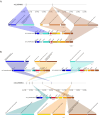Functional prediction of proteins from the human gut archaeome
- PMID: 38486809
- PMCID: PMC10939349
- DOI: 10.1093/ismeco/ycad014
Functional prediction of proteins from the human gut archaeome
Abstract
The human gastrointestinal tract contains diverse microbial communities, including archaea. Among them, Methanobrevibacter smithii represents a highly active and clinically relevant methanogenic archaeon, being involved in gastrointestinal disorders, such as inflammatory bowel disease and obesity. Herein, we present an integrated approach using sequence and structure information to improve the annotation of M. smithii proteins using advanced protein structure prediction and annotation tools, such as AlphaFold2, trRosetta, ProFunc, and DeepFri. Of an initial set of 873 481 archaeal proteins, we found 707 754 proteins exclusively present in the human gut. Having analysed archaeal proteins together with 87 282 994 bacterial proteins, we identified unique archaeal proteins and archaeal-bacterial homologs. We then predicted and characterized functional domains and structures of 73 unique and homologous archaeal protein clusters linked the human gut and M. smithii. We refined annotations based on the predicted structures, extending existing sequence similarity-based annotations. We identified gut-specific archaeal proteins that may be involved in defense mechanisms, virulence, adhesion, and the degradation of toxic substances. Interestingly, we identified potential glycosyltransferases that could be associated with N-linked and O-glycosylation. Additionally, we found preliminary evidence for interdomain horizontal gene transfer between Clostridia species and M. smithii, which includes sporulation Stage V proteins AE and AD. Our study broadens the understanding of archaeal biology, particularly M. smithii, and highlights the importance of considering both sequence and structure for the prediction of protein function.
Keywords: archaea; gut microbiome; methanogens; protein structure.
© The Author(s) 2024. Published by Oxford University Press on behalf of the International Society for Microbial Ecology.
Conflict of interest statement
None declared.
Figures





Similar articles
-
Reevaluation of the gastrointestinal methanogenic archaeome in multiple sclerosis and its association with treatment.Microbiol Spectr. 2025 Apr;13(4):e0218324. doi: 10.1128/spectrum.02183-24. Epub 2025 Feb 25. Microbiol Spectr. 2025. PMID: 39998261 Free PMC article.
-
Gut Colonization by Methanogenic Archaea Is Associated with Organic Dairy Consumption in Children.Front Microbiol. 2017 Mar 10;8:355. doi: 10.3389/fmicb.2017.00355. eCollection 2017. Front Microbiol. 2017. PMID: 28344572 Free PMC article.
-
Mutual Exclusion of Methanobrevibacter Species in the Human Gut Microbiota Facilitates Directed Cultivation of a Candidatus Methanobrevibacter Intestini Representative.Microbiol Spectr. 2022 Aug 31;10(4):e0084922. doi: 10.1128/spectrum.00849-22. Epub 2022 Jun 14. Microbiol Spectr. 2022. PMID: 35699469 Free PMC article.
-
Exploring the human archaeome: its relevance for health and disease, and its complex interplay with the human immune system.FEBS J. 2025 Mar;292(6):1316-1329. doi: 10.1111/febs.17123. Epub 2024 Mar 31. FEBS J. 2025. PMID: 38555566 Free PMC article. Review.
-
The host-associated archaeome.Nat Rev Microbiol. 2020 Nov;18(11):622-636. doi: 10.1038/s41579-020-0407-y. Epub 2020 Jul 20. Nat Rev Microbiol. 2020. PMID: 32690877 Review.
References
LinkOut - more resources
Full Text Sources

